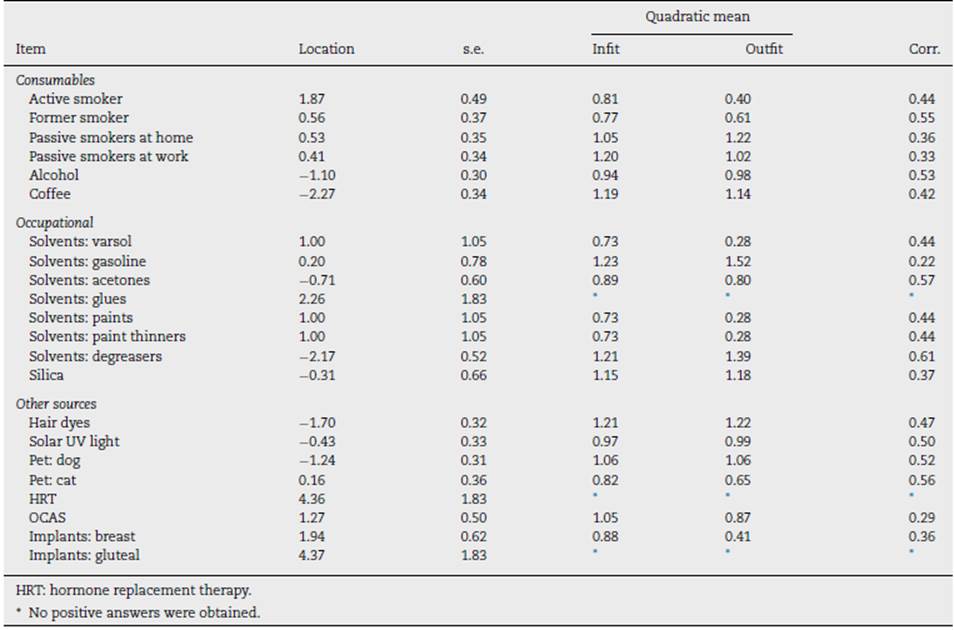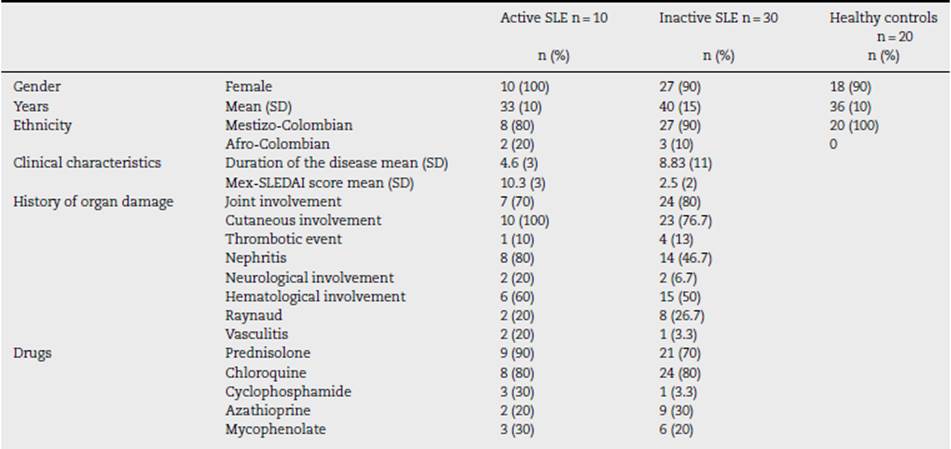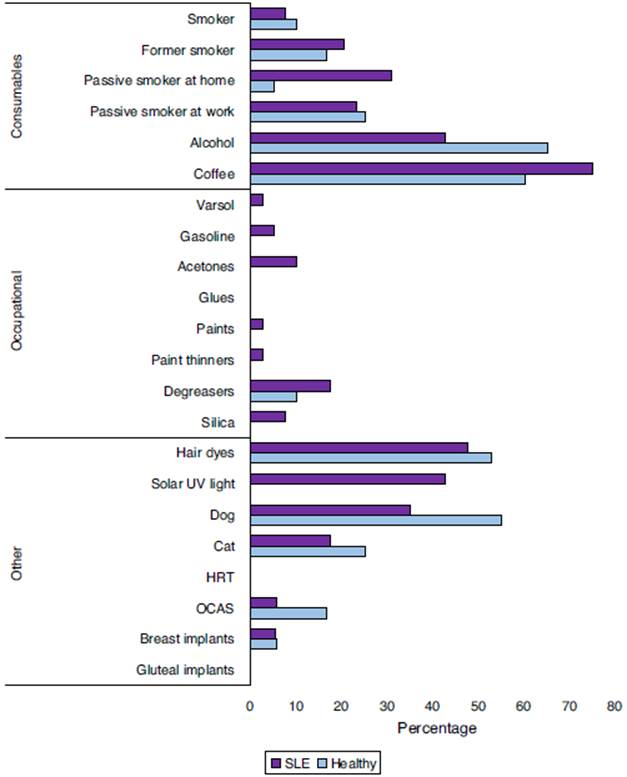Introduction
Systemic lupus erythematosus (SLE) is a complex chronic disease of autoimmune origin, which affects multiple organs1. It is characterized by the production of autoantibodies against DNA and other cellular elements. Its clinical manifestations are very heterogeneous and can affect any organ or tissue, especially the skin, the musculoskeletal and hematological systems, as well as the kidneys2.
The origin of SLE is multifactorial and involves both genetic susceptibility and triggers due to environmental exposure. The eminently genetic analyses only explain partially the development of this disease. Evidences such as the discordance between monozygotic twins suggest that environmental factors must play a relevant role in pathogenesis, through epigenetic changes3 in multiple types of immune cells4. In concordance with the hypothesis of the role of the environment, multiple specific factors have been associated with SLE. Among the most studied, the smoking habit5 and the exposure to ultraviolet light or silica6,7 stand out. Despite the epidemiological evidences of association, the studies on the interactions between these exposures and their burden in the disease are scarce.
In addition, it is known that environmental events can lead to epigenetic alterations; for example, a diet low in methionine and its precursors such as vitamin B12, folates, vitamin B6, among others, caused epigenetic changes such as hypomethylation of the DNA and the development of a lupuslike phenotype with nephritis in murine models8. Another evidence of the effects of the environment on lupus is the phenomenon of SLE induced by drugs such as procainamide and hydralazine, which directly cause epigenetic changes such as global hypomethylation in immune cells9. These evidences highlight the importance of having a way to establish and measure the exposure to different environmental events, both in research processes and in clinical practice.
While the research on the epigenetics of lupus has made great and rapid progress10, the availability of validated and standardized instruments for the measurement of the environmental exposure is insufficient to advance towards studies both of association and causality between the interaction of environmental factors and epigenetic changes. In the literature there are some instruments proposed to measure the exposure to factors, such as that of the World Health Organization (WHO) for tobacco and alcohol in the general population11, as well as questionnaires to detail the occupational exposure to silica, addressed to patients with SLE12. However, an instrument that allows physicians, rheumatologists and researchers in lupus to make a practical and standardized evaluation of the burden of exposure of the patients to multiple environmental factors is not currently available. For this reason, the objective of this study was the construction and exploratory evaluation of the psychometric properties of a questionnaire-type instrument for the characterization of environmental exposures associated with SLE.
Materials and methods
Design
Study of construction and exploratory evaluation of the psychometric characteristics of a questionnaire. This is a sub-study nested in a case-control work that aimed to characterize the subpopulations of B-cells and their relationship with environmental exposure, DNA methylation and the disease activity in patients with SLE.
The study received the approval of the Ethics Committee for Research in Humans of the CES University and all participants signed an informed consent.
Participants
The original study was conducted with 60 participants, 40 patients with lupus and 20 healthy controls. The inclusion criteria for the patients were: (1) patients of 18 years or older and (2) who at the time of diagnosis fulfilled 4 or more classification criteria of the American College of Rheumatology of 198213. The patients with drug-induced SLE, polyautoimmunity, recent treatment with biological agents, infection or antecedents of cancer were excluded. The inclusion and exclusion criteria were verified in the medical records of the patients. The patients with SLE were recruited in the Outpatient Service of a healthcare provider institution (IPS, by its acronym in Spanish), a reference center for the treatment of autoimmune diseases in the city of Medellín.
As for the healthy participants, people from the community without SLE, matched by age (±5 years) and gender, recruited among volunteer employees and students of a university in the city of Medellín were included. Those with a history of autoimmunity, infection or antecedents of cancer were excluded as controls.
Clinical variables
The evaluation of the clinical variables was conducted in two stages, the first was the obtention of the data on how the diagnosis, organ compromises and treatment of the patients were established, which was done by reviewing the clinical history. In a second stage, a face-to-face visit was carried out, which allowed to establish the activity of the disease by questioning about the symptoms and signs of activity of the Mex SLEDAI, and in which the instrument was applied.
The Mex SLEDAI score14, which has been validated with the SLEDAI index15,16, was used to classify the active and inactive patients. Those patients who had a score higher than or equal to 7 were considered active, as mentioned by Ayala Saucedo et al.17.
Construction of the instrument
A literature review on physical-chemical and occupational environmental factors associated with SLE was conducted, emphasizing the availability of questionnaire-type instruments applied in patients with this disease. All the factors measurable by self-report identified in the literature were used for the construction of the statement and the format of answers of the items.
Three questionnaires designed and applied in patients with SLE were identified in the review. Each of these instruments assessed the exposure to silica12, hair dyes18 and sunlight19, therefore, the same statements and the same answer options reported in these articles were used. On the other hand, there were four questionnaires applied to the general population or to populations with other diseases, which characterized the exposure to coffee20, organic solvents21, tobacco and alcohol11.
Other environmental factors associated with lupus were the coexistence with pets, the use of hormonal replacement therapy, the use of oral contraceptives (OCAS) and breast and gluteal implants6; however, questionnaires to characterize their exposure were not found. New questions and types of answers were designed for the last 5 factors, emphasizing the frequency, intensity and time of exposure.
Additionally, the questions about environmental exposure asked routinely in the medical record of the IPS Artmedica were taken as reference. Starting from this, the groups of environmental factors studied for SLE were determined and the test plan was constructed to determine the content categories of the questionnaire.
Once the selection of the physical-chemical and occupational environmental factors to be included in the questionnaire was completed, the items were grouped by dimensions according to whether they were «consumable» factors such alcohol, «occupational» such as organic solvents and «other» such as sunlight.
Next, a plan was made of how many types of questions each factor should have. For example, for the cigarette factor it was inquired on the presence or absence of being active smoker, former smoker, passive smoker at home, passive smoker at work, among others, with a total of seven questions in which their answer option was Yes or No. Then there were two questions that inquired about the frequency per day and per week of smoking, added to two other questions about the time of exposure with an answer format in number of years of exposure. In the case of hair dyes, the question on the type of chemical was added, with an answer format to select whether permanent or non-permanent tincture was used. Finally, in the exposure to organic solvents, the fifth type of question on the use of protective elements, such gloves or face masks, among others, was added. The complete plan with the number of each type of question in each environmental factor is summarized in Table 1.
Table 1 Structure proposed for the questionnaire. Numbers of each type of question for each of the environmental factors included in the questionnaire.
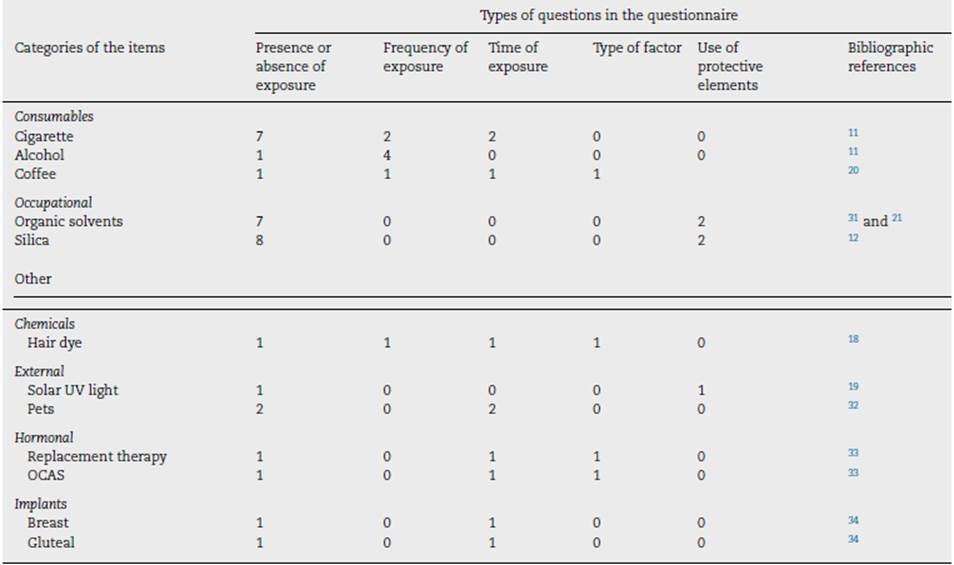
The final questionnaire included 59 questions related to physical-chemical and occupational exposures that were compiled in a form in Excel®, which was applied in person to the patients with SLE after their scheduled consultation with the Rheumatology service.
Review by judges, modifications to the instrument and pilot
The questionnaire was revised by experts, among them a rheumatologist, doctor in immunology, with clinical and research experience in SLE; a biologist, with a master degree in epidemiology, with experience in occupational health; a zootechnician, with a doctorate in animal sciences and experience in epigenetics; and a psychologist, doctor in epidemiology and biostatistics, with experience in psychometric measurement and analysis. The feedback of experts was included in the preliminary version of the instrument. In addition, it was conducted a pilot study with healthy individuals of different ages and levels of education to verify the application time and the understanding of the questions.
Statistical analysis
Exploratory analysis of psychometric properties Exploratory analyses of the psychometric properties were conducted using the Rasch model22, which establishes that a positive answer from a person n to an item i (Xni = 1) is a probabilistic function of the quantity of attribute of the person (θn) and the difficulty of the item (δi), so the probability of positive answer of an individual with a determined attribute level for an item is equal to  .
.
The Rasch analysis is focused on establishing if from the answers obtained through an instrument, it is possible to obtain a representation in interval scale, invariant and unidimensional of a latent attribute. This is determined from the valoration of a set of statistics with which the adjustment of the data to the model assumptions is evaluated 23.
Performance of the response function
The distribution of answers of the total of items was calculated in frequencies and percentages for each dimension. For the two answer options, the coherences measure-category (M→C) and category-measure (C→M), which quantify the percentage of answers to the item that are predictable from the total of the instrument and the percentage of the total values of the instrument which are predictable from the answers to the items were calculated, respectively. The expected value was at least40%. In addition, the reproducibility of the answers to the items of each dimension was estimated using the Guttman coefficient.
Adjustment of the items. The locations and standard errors, expressed in logits (logarithm of the Odds of positive answer) were estimated for the items of each dimension. The adjustment of the items to the assumptions of the metric method was quantified by quadratic means of Infit and Outfit, with expected values within the range 0.5 1.5. In addition, the correlations between the Rasch estimates of the item and the total of each dimension with positive expected values and higher than 0.3 were estimated.
Reliability. Once the adjustment to the model assumptions was analyzed, the reliability was estimated by the Wright method24 with an expected value higher than 0.7.
Descriptive analysis
Quantitative variables were analyzed with means and standard deviations, while frequencies and percentages were used for categorical variables. The characteristics of the participants are presented by subgroups according to patients and controls, the frequency of exposure to environmental factors is described, and the co-occurrence of exposures is analyzed using Venn diagrams. Likewise, descriptive analyses of exposure frequencies in patients and healthy controls were carried out. The analyses were executed in WINSTEPS 4.5.0® and in the BioVinci® software.
Results
Application of the questionnaire
The instrument was practical and easy to understand by patients and healthy participants. The approximate time for its application was 10 20 min, depending on the number of positive exposures.
Exploratory analysis of psychometric properties
Regarding the dimension of consumables, 32% of the answers were positive, with C and M coherences higher than 70% and a reproducibility of 80%. In relation to the dimension of occupational exposures, 4% of the answers were positive, with coherences higher than 80% in the option «No» and a reproducibility of 80%. Nevertheless, the coherences of the option «Yes» were less than 40% (probably due to the few answers to the items of silica). Finally, in the dimension of other exposures, 20% of the answers were positive, with coherences higher than 50% and a reproducibility of 76%. The coherences and reproducibilities of the performance of the response function are shown in Table 2.
Regarding to the adjustment of the items to the model, the three dimensions of the items presented Infit categories within the expected range of 0.5-1.5, as well as positive correlations. All the correlations were higher than 0.3, with the exception of the items «solvents: gasoline» and «OCAS», with values of 0.22 and 0.29, respectively. The outfit adjustment was within the expected range for 14 items. The items «active smoker», «solvents: varsol», «solvents: paint», «solvents: paint thinners», and «implants: breast» obtained quadratic means <0.5, evidence of overfitting to the model assumptions. The items «solvents: glue», «HRT» and «implants: gluteal» could not be assessed since all the answers were negative (Table 3).
The Wright reliabilities of the scales were 0.75 for consumables, and 0.58 for occupational, while the dimension of other exposures obtained a value of 0.69.
Final version of the questionnaire
Due to the low values obtained for the items of silica, it was decided to collapse these questions, as shown in Chart 1. In addition, the fact of having 7 questions with the answer format Yes or No in tobacco and having 4 questions on the frequency of alcohol consumption was identified as repetitive, therefore, it was decided to cut these items, to finally leave 4 questions on the presence or absence of exposure to tobacco and only one question of frequency type for alcohol.
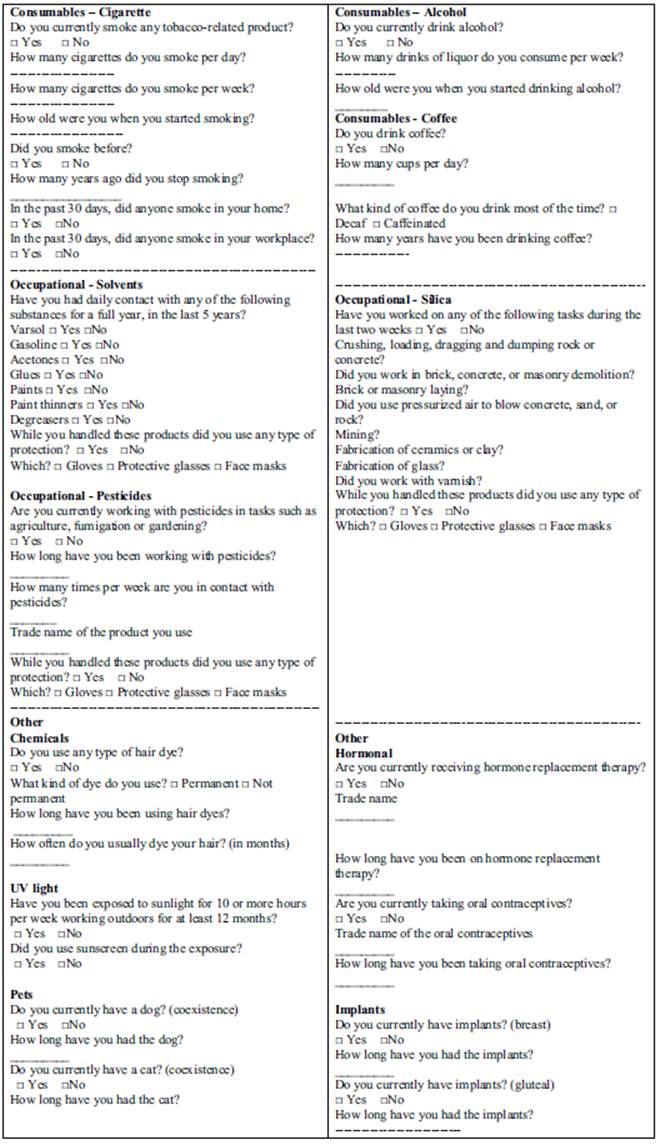
EXPOSURE TO ENVIRONMENTAL FACTORS IN PATIENTS WITH LUPUS
Chart 1 Final version of the questionnaire.
On the other hand, one of the patients reported as occupation being a farmer and presenting exposure to pesticides during the last 20 years, although it was not found as an item in the questionnaire. This highlighted the need to include a new item in the category of occupational factors in the final version of the questionnaire described in Chart 1.
Description of the environmental factors
40 patients with SLE and 20 healthy controls were evaluated, 90% were women, with a mean age of 39 years (SD 15). The distribution of patients with SLE according to the disease activity involved 10 active patients and 30 inactive patients, classified according to the MEX-SLEDAI index. 82.5% of the patients had cutaneous involvement, 77.5% joint involvement, whereas 55% had nephritis. As for the treatment, the patients received mainly steroids and chloroquine (Table 4).
Regarding the descriptive data obtained with the questionnaire, the environmental factor to which the patients with SLE were more exposed was coffee consumption, with 75% of exposure, followed by hair dyes with 47.5% and UV light with 42.5%. On the other hand, in healthy individuals, alcohol consumption was the most frequent environmental factor, with 65%, followed by coffee in 60% and pets (such as dogs) in 55%. Exposure to UV light or to silica was not found in any of the healthy individuals (Fig. 1).
On the other hand, the high overlap of environmental exposures was a notorious characteristic in the patients. 82.5% of them were simultaneously exposed to three or more factors, 25% had 6 or more exposures and only one patient presented the highest number of co-occurrences, with 8 positive environmental factors (Fig. 2A). This concept could be explored later to try to understand how multiple environmental factors interact and their relationship with the disease.
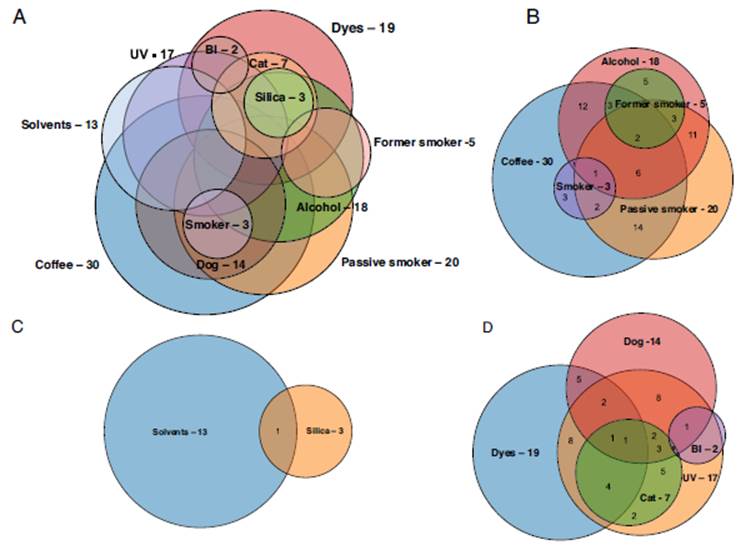
Fig. 2 Venn diagrams of the patients with SLE exposed to different environmental factors. (A) Proportional Venn diagram, the size of each circle is equivalent to the number of patients exposed. (B) Venn diagram with the category of occupational factors (D) Venn diagram with the category of others. The construction of the Venn diagrams was conducted with the BioVinci® software. BI: Breast implant.
To make easy the analysis of the intersections, environmental factors were separated into consumable, occupational and other categories. The exposure to organic solvents, ultraviolet light and the consumption of alcohol showed the highest number of intersections with other environmental factors. (Fig. 2B-D). As for the intra-category overlap, consumables showed the highest number of intersections with each other.
As for the healthy individuals a high overlapping of environmental factors was observed in the participants; 65% had been exposed to 3 or more factors, 15% had 6 or more exposures and only one person had 7 positive environmental factors (Fig. 3). Like in the patients, the consumable factors showed the highest number of intra-category intersections.
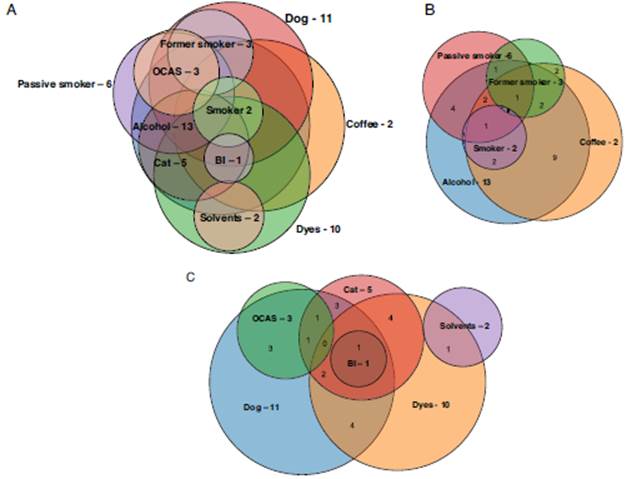
Fig. 3 Venn diagrams of the healthy individuals exposed to different environmental factors. (A) Proportional Venn diagram, the size of each circle is equivalent to the number of exposed patients, (B) Venn diagram with the category consumables. (C) Venn diagram with the category of occupational and other factors. The construction of the Venn diagrams was performed with the BioVinci® software. BI: Breast implant.
Finally, the patients with SLE showed greater co-occurrence of 3 or more environmental factors than the healthy controls (82.5 vs. 65%).
Discussion
This study presents a practical and easy-to-apply questionnaire to characterize multiple environmental exposures in patients with SLE. The instrument showed a favorable performance according to the exploratory analysis of its psychometric properties. This analysis also allowed to refine the questionnaire by identifying repetitive questions, as well as low values in the psychometric analysis in the factor of silica, showing the need to make changes in some items in the final version (Chart 1).
Specific environmental factors have been described as triggers of SLE in general, as well as of specific symptoms25. Perhaps the best known is the association between solar UV light and photosensitivity, an exposure that can also cause the reactivation of the disease26. Another frequent exposure factor in the general population is the smoking habit. In particular, a recent study with a Colombian population of patients with lupus nephritis described smoking for the first time as a risk factor for nephritis in patients with SLE27. In other studies, it has been described an association between specific occupational exposures (silica powder, mixture or application of pesticides and sunlight) and high titers of antinuclear antibodies ≥1:16019.
However, the environmental effects on the pathophysiology of lupus represent challenges that cannot be analyzed unidirectionally and with each factor isolated. Indeed, this study identified the co-occurrence of multiple environmental factors in a relevant fraction of patients, which highlights the complexity of the study of environmental exposure and its relationship with SLE.
One of the few studies that analyze the effect of the summation of environmental factors in SLE describes that patients who presented a sum of factors, especially those with three or more factors, showed a tendency to have higher titers of antinuclear antibodies (ANA)19. Remarkably, the majority of patients in this study were exposed to three or more environmental factors.
Another study made a detailed characterization through structured interviews that lasted 45 min which inquired in detail about the work history, leisure activities and hobbies. This work reported the exposure of patients with SLE and healthy individuals to tobacco, sunlight, hair dyes, silica, organic solvents, pesticides and mercury. Even though they found differences between patients and healthy individuals in the proportions of exposure for each factor, an analysis of interactions or summation of factors and their possible associations was not carried out28.
Although not necessarily a patient with more exposures would have always a higher risk than another with a lower number of exposures, since the variables would not have the same weight in the development of the disease, the need for more research to determine which risk factors affect more the patients is highlighted. On the other hand, the combination of certain environmental factors could potentiate the onset of activity crises in the patients. To clarify these questions in the context of the summation or combination of multiple environmental factors, it is imperative to characterize simultaneously the multiple factors to which patients are exposed.
None of the 7 questionnaires identified in the literature to characterize environmental exposure in lupus or in the general population had a validation of its psychometric properties, that constitutes a fundamental step towards the standardization of environmental measurement, which is necessary to advance in the studies of clinical association and to elucidate causality in epigenetic changes29. In this sense, the present work provided the first.
Spanish version of a questionnaire to characterize several environmental factors in patients with lupus, with an acceptable preliminary validation of its psychometric properties.
In addition, the instruments of questionnaire type have important advantages since they allow to inquire about the exposure in cases of chemicals with a very short half-life such as organic solvents. Likewise, due to their viability, low cost and application they can be conducted in a variety of formats, either in person, by telephone, or online, among others12.
The main limitation of this study was the fact of having a small sample, but only were affected 3 items that did not have any positive answer. However, this sample is considered sufficient for exploratory psychometric analyses with items which have a dichotomous answer30. On the other hand, the reliability of the occupational section was lower than 0.7, which can be attributed to the homogeneity in the exposure. This must be verified in further studies carried out with samples of greater heterogeneity, which will also allow to verify the psychometric properties of the final version of the questionnaire, as well as to evaluate the reproducibility and the intraobserver variability.
Other limitations are inherent to the questionnaires, such as a possible information bias due to failures in the memory of the participants when they tried to remember the exposures. For this, questions on concrete tasks can be used, as recommended by Parks et al. in a study in which they reviewed several questionnaires for the exposure to silica in patients with SLE, and highlighted the importance of designing clear questions for specific tasks12.
Conclusion
The patients with SLE are exposed to multiple environmental factors, which were characterized with an instrument of questionnaire-type which showed a favorable performance in its psychometric properties. According to our knowledge, this is the first time that an instrument of this type is proposed, designed specifically for patients with SLE, in Spanish and with a validation that will allow the reproducibility in future studies.
Contributions
Carolina Hurtado participated in the design of the study, generation of the instrument, pilot test, data collection, analysis and interpretation, writing of the manuscript and approval of the final version.
Diego Rojas participated in the analysis and interpretation of the data, generation of the instrument, writing of the manuscript and approval of the final version.
Deicy Hernández, Juan Camilo Díaz and Ricardo Pineda participated in the generation of the instrument, data collection and approval of the final version of the manuscript.
Rodrigo Urrego and Elsa Vásquez participated in the design of the study, generation of the instrument, writing of the manuscript and approval of the final version.
Gloria Vásquez participated in the design of the study, collection, analysis and interpretation of the data, writing of the manuscript and approval of the final version.











 texto en
texto en 


